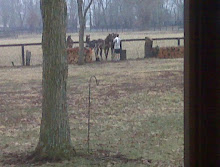What a joke, NTRA Safety Accreditation of tracks to 'ensure' equine safety. A noble premise, I guess, but totally missing the mark in my opinion.
How about requiring the horse to pass a 'stress' test before being allowed to race?
Let's make the trainer prove his/her horse is fit to complete a 6 furlong breeze within 2 weeks of raceday, before being allowed to enter a faster, longer, more demanding event?
Take the Kentucky Derby for instance, 10 furlongs over dirt. The most elite equine athletes in the world should be able to first handle a 6 furlong breeze in the 2 weeks prior to the big day.
Your proposed starter better show us that he can breeze 6 furlongs at Churchill in a reasonable time, say 1:15 or better (from a gated start would be nice, but I know that is asking too much) AND demonstrate, via on-board heart rate monitor, a recovery heart rate of under 120bpm in the first 120 seconds after starting his gallop out. This data collection takes about 30 seconds.
You see, running several sub 13sec furlongs builds up an oxygen debt in a horse. When the breeze ends, the athlete has to pay that debt back through an elevated heart rate - the quicker that heart rate sinks back to below 120bpm, the faster the oxygen debt was repaid - the fitter/sounder the horse. Any pre-existing conditions that could lead to a fatal breakdown will be exposed via improper recovery heart rate.
You see, there already exists a precedent for using a heart rate monitor in conjunction with equine racing.
Many endurance races of 30 miles and over require the checking of an exercising horse’s heart rate during several checkpoints throughout the course.
Should the heart rate fall outside of the normal ranges, the horse is disqualified from the competition and immediately examined by trained personnel.
Watching a horse walk is not enough. We already have a ton of subjective opinions, it's time to add some objective numerical data to the picture.
Subscribe to:
Post Comments (Atom)




I think this is a great idea and a good starting point for horse safety cause a good vet will know what is a normal reaction for a horse breezing and if they don't react normally it may expose drugs in the horses system that shouldn't be there. We have to get rid of these drugs somehow.
ReplyDeleteMost vets won't know an appropriate heart rate response to a breeze.
ReplyDeleteEven if they did, they would have to be standing on the backstretch ready to take a reading as soon as the gallop out is over.
We need to add the same technological advancements to the training process of horses that humans started using 20 years ago.
Endurance riders do it, why can't thoroughbred guys?
Bill,
ReplyDeleteWhen talking about checking the heart rate on a racehorse, would it be possible to place a telemetry strap inside the girth which would communicate with a watch or another form of a telemetry unit that records the info on a memory stick? The collection of date could be instantaneous (mem. stick into a laptop or desktop) and the unit transferable from horse to horse to keep cost down for smaller stables.
The unit would be carried by the jockey to keep from disturbing the horse's biomechanics. From what I've read, the chest area right behind the elbow is where heart rate is taken on a horse...seems like a no-brainer to me.
Compelling stuff. I'll check back again.
Amaeturcapper-
ReplyDeleteThanks for the note. We have been able to shoot HR via telemety system to a laptop nearby, with a range of only 100m so far. We haven't been able to coming GPS/speed info with that info, yet.
I often use a single strap/watch/GPS unit for up to 10 horses in a morning, as long as they have the same rider.
Not every horse needs the whole set-up, just each rider